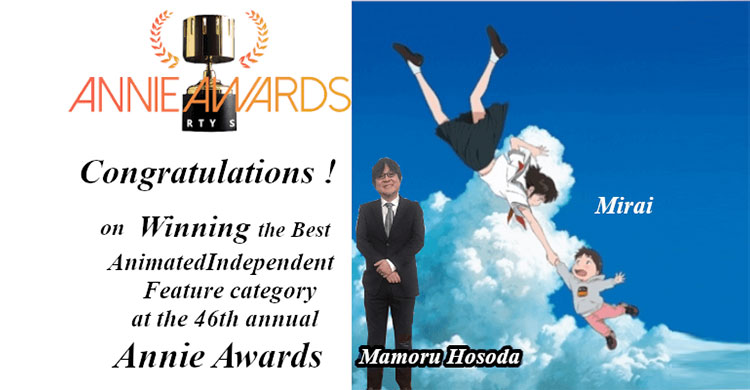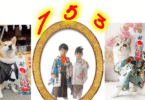Hi everyone how are you? We are happy to announce you that Mamoru Hosoda’s film “Mirai” won the Best Animated Independent Feature category at the 46th annual Annie Awards on Saturday(on Feb 2,2019) with the focus now on whether the anime fantasy will receive the Academy Award for Best Animated Feature to be announced later in the month.
Here’s the big news from Kyodo of Japan’s leading news agency.
LOS ANGELES – Mamoru Hosoda’s film “Mirai” won the best animated independent feature category at the 46th annual Annie Awards on Saturday.
“This film is modeled after my child. I made the film thinking how great it was to play with small children,” Hosoda said at the ceremony in Los Angeles.
Organized by ASIFA-Hollywood, also known as the International Animated Film Society, the Annie Awards are considered among the highest accolades in the animation production industry and often dubbed the Academy Awards for animation.
Hosoda, touted as a possible successor to Japan’s famed director Hayao Miyazaki, is best known for “Toki wo Kakeru Shojo” (“The Girl Who Leapt Through Time”) in 2006, and “Bakemono no Ko” (“The Boy and the Beast”) in 2015.
The best animated independent feature category covers animation films with smaller distribution than major studio releases, being shown at fewer than 1,000 theaters in the United States.
“MFKZ,” co-directed by Shojiro Nishimi from Japan and Guillaume “Run” Renard from France, was also nominated for the independent feature category award but missed out.
In 2017, “The Red Turtle,” produced by Studio Ghibli in collaboration with other companies, took the best animated independent feature award. Studio Ghibli is best known for the award-winning works of Miyazaki.
“Mirai” has also been nominated for an Oscar in the Animated Feature Film category.
The others nominated in the same category are “Spider-Man: Into the Spider-Verse,” “Incredibles 2,” “Isle of Dogs” and “Ralph Breaks the Internet.”
“I am very surprised that ‘Mirai’ has been nominated for a 91st Academy Award,” Hosoda said on Jan. 23 on his animation studio’s blog.
What’s Annie Awards?
The Annie Awards are accolades presented annually by the Los Angeles branch of the International Animated Film Association, ASIFA-Hollywood since 1972, to recognize excellence in animation in film and television.
Originally designed to celebrate lifetime or career contributions to animation, since 1992 it has given awards to individual films.
Memberships in the ASIFA-Hollywood consist of three main categories: General Member, Patron and Student Member.
Joining ASIFA-Hollywood is open to professionals, students and fans of animation, for a membership fee. Selected professional members are permitted to vote for the Annie.
The 46th Annie Awards ceremony took place on February 2, 2019, on the campus of UCLA.
History of Award
In 1972, June Foray conceived the idea that there should be awards for animation as there were no awards for the field. With the approval of ASIFA-Hollywood president Nick Bosustow, Annie Awards ceremony was organized.
The first ceremony was held at the banquet room of Sportsmen’s Lodge in Ventura Boulevard in Studio City, Los Angeles, California.
Max Fleischer and Dave Fleischer were the first to be honored by the first Annie Awards for creating the characters Betty Boop, Popeye and Olive Oyl, and for inventing the technique of rotoscoping.
★ Naming “Annie Awards”
According to Foray, her husband Hobart Donavan suggested that the awards be called “Annie” since the awards are for excellence in animation.
★ Trophy
The first Annie Award trophy was given out in the second awards ceremony to Walter Lantz, the founder of Walter Lantz Productions and creator of Woody Woodpecker. The trophy was a brass prize shaped like a zoetrope and was made out of wood and plastic. The next year, Tom Woodward came up with the current design.
Finally, we have another website related to anime, “Animation or Anime from Japan” to be well worth a visit, thanks








